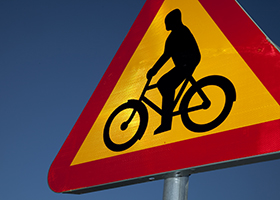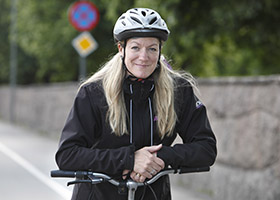The Länsförsäkringsbolagen (Swedish County Insurance Companies) research fund has been financing a three-year research programme under the auspices of the Swedish National Road and Transport Research Institute (VTI) since the spring of 2015. The aim is to improve the safety of unprotected wheel-borne road users.
Some of the projects included in the programme were presented at the Transportforum 2017 conference. For example, VTI’s Henriette Wallén Warner reported on views of alcohol use in connection with cycling.

Acceptance of introducing a blood alcohol limit for cyclists is low.
Photo: VTI/Katja Kircher
Of the 236 cyclists who died on Swedish roads between 2006 and 2015, 11% were under the influence of alcohol. More may have been, but tests to detect the presence of alcohol were never performed. On the other hand, a study from Umeå has demonstrated that roughly 40% of cyclists who came to Norrland University Hospital with skull injuries had alcohol in their bodies.
Wallén Warner’s interview study reveals that those who ride bicycles under the influence of alcohol range all the way from the slightly tipsy to those who are so affected that they nearly fall off their bikes.
The interviewees expressed the general belief that “everyone else does the same thing I’m doing”. Most also feel that cycling under the influence is acceptable, assuming nothing happens. If something does happen, then it becomes embarrassing to talk about it.
Low acceptance of a blood alcohol limit
“Acceptance of introducing a blood alcohol limit for cyclists is low. The interviewees perceive so many advantages in going by bicycle. They get themselves from door to door, and avoid having to conform to public transport timetables. If we want to change cyclists’ behaviour in this regard, we have to aim at changing attitudes and norms”, said Wallén Warner.
As a group, cyclists tend to have a more negative attitude towards traffic regulations than do car drivers.
“This may be because the traffic system is tailored primarily for car users, and not for cyclists”, said VTI researcher Gunilla Björklund, who presented results of a questionnaire study concerning the interaction between various road users in traffic.
The most common transgressions perpetrated by cyclists are failing to stop at stop signs and riding on sidewalks and pedestrian paths. Nor is it that uncommon for cyclists to run red lights or fail to stop and then proceed across pedestrian crossings while walking their bikes.
Cyclists who have driving licences ride drunk more often than do those without driving licenses. They are also more likely to ride on the main road even when there is a bicycle lane alongside.
Crash tests on bicycles
Most bicycle accidents are single-vehicle accidents, and crash tests with bicycles have been carried out at VTI to study the importance of height and riding position in terms of the injury outcome.

Anna Niska, Researcher at VTI.
Photo: Hejdlösa Bilder
“We focused on two types of accidents: avoidance steering with the front wheel, which simulates a skid, and sudden stops”, said VTI researcher Anna Niska.
The tests were performed using a crash test dummy at rest, at 15 kmh, and at 25 kmh.
A sudden stop generally causes the most severe ground impact, and the higher the bicycle seat, the more powerful the impact.
Electric bicycles are heavier, with a different centre of gravity, and are thus at lower risk of flipping. We can also see that a position in which the cyclist is inclined forward (e.g., as on racing bikes) results in a somewhat greater risk of landing head first, while traditional women’s bicycles result in more falls in which the hips and shoulders hit before the head.
This article is a report from the VTI conference Transportforum 2017 (session 79). You find more information about the conference here (in Swedish). Text: Catarina Gisby






Follow us: